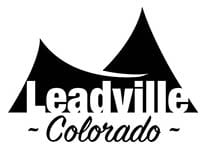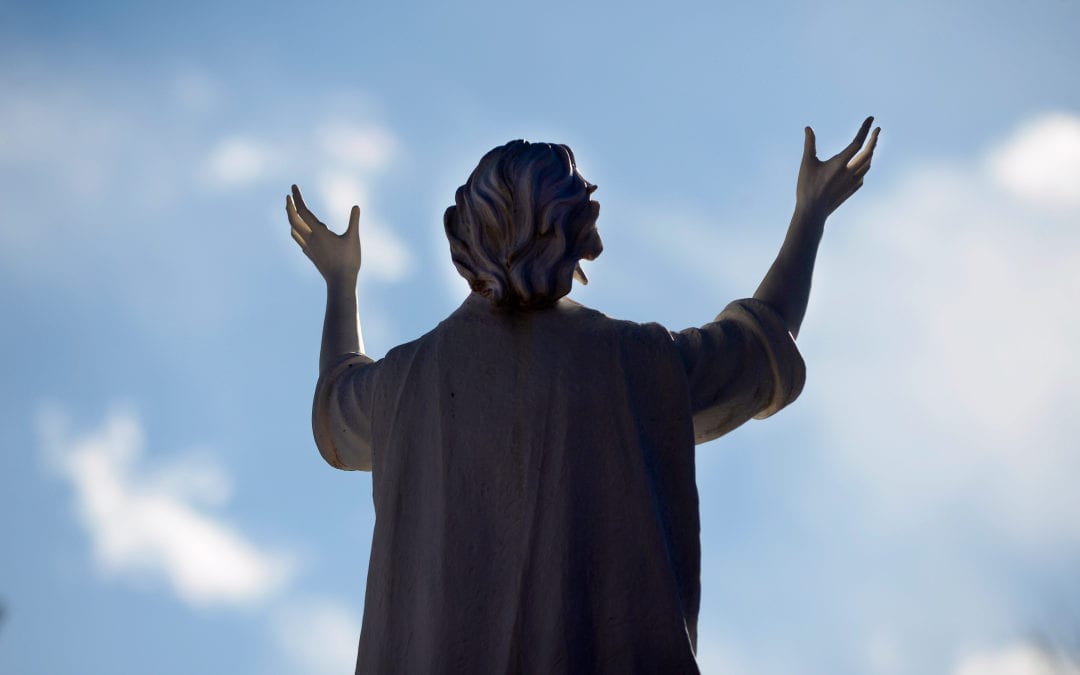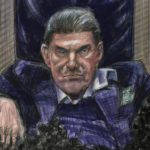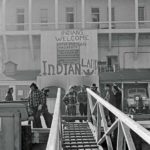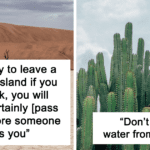He walked to the microphone in a dark suit and tie, a nervous purpose in his stride.
One year ago this week, Gov. Jared Polis stood in a conference room at the Colorado Department of Public Health and Environment’s headquarters and looked into the hot glare of television lights. He had come to announce the first confirmed cases of coronavirus infection in the state, but his words repeatedly sought to reassure.
“At this point in time, again, there are greater health threats in Colorado,” he said.
This is part of a weeklong series marking a year since COVID-19 was first detected in Colorado. The state’s first confirmed cases were announced March 5, 2020.
But by then, the virus was already spreading in multiple communities. The first people who would die from it were already infected. The state’s pandemic year had begun, and so, too, had a story of fear and loss and change. A story that often unfolded in isolation. A story written through the grief of one family at a time — families, like Anna Trujillo Pacheco’s.
Anna was a headstrong matriarch to five generations of first-born women. She was generous to a fault, loved every member of her vast family and hated that she couldn’t hug them during a once-in-a-century health crisis.
When her daughter, granddaughter and great-granddaughter remember Anna, they feel sad that she had to live out her fear of dying alone in a hospital bed in Denver. They feel guilty that they didn’t check up on her more often. They feel angry that she got coronavirus in the first place.
“It’s just heartbreaking,” Anna’s daughter Jeanette Esquibel said, “just to not be able to talk to your mama.”

Unfathomable loss
When Polis announced those first cases on March 5, 2020, there were approximately 5.8 million people living in Colorado. In the year that followed, the virus killed more than 5,800 of us. One out of every 1,000 Coloradans alive at the beginning of the pandemic fell victim to it.
The scope of the tragedy is difficult to comprehend using common comparisons. The death toll is larger than the number of Coloradans killed in World War I, World War II, the Korean War and the Vietnam War combined. It is larger than the populations of Vail, or Eaton, or Manitou Springs. It is larger than the number of people living in a quarter of the state’s counties. It is so large that a minute of remembrance for each victim would require four days of silence.
This has been a year-long mass casualty incident, each day its own, new, terrible tragedy.

Yet, for all this loss, it has also been nearly invisible to the public at-large. Sheltered away at home, shielded beneath masks, instructed to keep a distance, many in the public have experienced the virus’ devastation as something that happens just out of view — in other people’s houses, in employees-only meatpacking plants, in locked-down prisons, in off-limits hospital wards, in nursing homes closed to visitors, in cemeteries limiting the size of services.
This disconnect, so unlike any major tragedy in modern times where public vigils and memorials are the norm, has given our collective grief an aimless, combative quality. And there is no shortage of reasons for grief.
Grief over lost jobs. Grief over shuttered businesses. Grief over dashed dreams. Grief over mounting stress, over missed opportunity, over loneliness, over anxiety, over despair, over the lives we thought we would be living.
We’ve fought about whose grief matters more. We’ve fought about whose lives matter more.
And this has created a bewildering landscape for people whose loved ones have died from the virus — at once struggling to comprehend their loss and struggling to comprehend the arguments surrounding it. Struggling through the legacy of the tragedy we all lived but hardly saw.

“You beat yourself up”
The last time Jeanette Esquibel saw her mother in person was late October. A survivor of both breast and kidney cancers, Anna turned 81 on Oct. 27, and she wanted to celebrate with some of her family. When everyone gathered for a picture, family members helped hold her up, much to her chagrin.
“She says, ‘Why are you holding me up?’” Esquibel said. “And I said, ‘Because you couldn’t stand up.’ And she said, ‘I could, if you had gave me enough time.’ She was very happy that day.”
Anna had been living with one of her brothers for the past few years, and he got sick soon after her birthday. She quarantined in her room, but was clearly not doing well. Once doctors realized she was COVID-19-positive, her care quickly cascaded. When her oxygen levels dropped dangerously low on Nov. 8, in-home hospice turned into an ambulance ride to Englewood’s Swedish Medical Center.
She stayed in the hospital for almost five days, first in the intensive care unit and then in the COVID ward. The day before Anna died, doctors told her family that she was having a good day, so that evening, relatives from around the world logged on to a video call to talk with her. She could hardly breathe, but she said everyone’s names and listened as they told her that they loved her. She told them she was ready to go.
“She said, ‘This is really hard,’” Esquibel said. “She said she was ready to be with the angels and God, the angels were on the staircase singing.”
Esquibel couldn’t sleep that night. She thinks she finally dozed off at home around 3 a.m., but woke up again around 5 a.m. on Nov. 13, right as a nurse at Swedish was checking on her mother to administer pain medicine. When the nurse returned around 6 a.m., Anna Trujillo Pacheco had passed away.
“You beat yourself up” for not calling to check in, Esquibel said. “It’s just something that I think everybody feels that way. And there’s nothing that you could do about it. So just be happy that you were able to talk to her before.”

If there wasn’t a deadly respiratory virus still circulating, Anna’s descendants would have gathered in droves at the Veterans of Foreign Wars post off West Colfax Avenue in Denver, like they have for most family occasions. People would filter in and out during the day-long event, a combination of mourning and celebration of the person who connected them all.
Eventually she will be buried at Fort Logan National Cemetery next to her husband Jose Pacheco, who served in Korea. But the cemetery currently has a limit of five attendees for burial services, and limits at mortuaries barely accommodate one lineage of the many that Anna anchored.
For now, the family is settling for less. Her granddaughter Ana Evans wrote Anna’s obituary and posted her story to the Coronavirus Lost Loved Ones map, a crowdsourced project between the mapping company Esri and volunteer mapping group GISCorps. And family members are slowly divvying up Anna’s various belongings, though she had already handed down some mementos as she aged. Her great-granddaughter Desiree Hooston has her wedding ring; Evans has her perfume.
Until the burial service, Anna’s ashes are split between Esquibel, who lives in Denver, and Evans and Hooston, who live in Salida. It’s been painful, Evans says, “to not honor her with our whole family.”
Hooston’s older children, a 7-year-old daughter and 4-year-old son, will likely remember Anna. But she wonders how she’ll talk about this time with them, as well as her 18-month-old girl and a fourth child, who is due this autumn. What will she tell them about their family matriarch, about why they never met? How will she talk about the thousands of others who came to the same fate?
“They need to know how bad it was taken care of and they need to remember that, and they need to remember that because of that, Grandma had passed away,” Hooston said.
Hooston wonders, had the pandemic not been so politicized from the start, if fewer people would have died. If her great-grandmother would still be alive. Losing someone you know — let alone the woman whose house was always a safe, warm place to be when you were young — is a whole different story than seeing the case and death rates rise. And yet, she says, people still refuse to wear a mask.
“They don’t have sympathy or empathy,” Hooston said. “They can’t just do one simple thing to help other people. … It just is everybody for themselves. Nobody cares about anybody else.”

The morbid middle ground
On April 12, 1955, church bells rang out in towns across America. Schools closed early. People danced. Ticker-tape parades soon formed.
The occasion was the announcement of a successful vaccine against polio, a disease that had killed or paralyzed tens of thousands of people, especially children, in the United States each year. Outbreaks through the 1940’s and ‘50’s sowed fear across the country. Terrified parents refused to let their children go to public swimming pools, believing them to be fertile grounds for the virus.
But it was the photos — whole hospital wards and high school gyms filled with patients encased in iron lungs — that had truly united the country against the disease, said Dr. Jon Andrus, an internationally known expert in polio vaccination who is an adjunct professor at the Colorado School of Public Health’s Center for Global Health.
Those visceral images led to a collective understanding: the disease must be defeated. More than 300,000 people signed up to work on the clinical trial for the vaccine in the United States; nearly 2 million children participated as trial subjects — numbers that dwarf any of the coronavirus vaccine trials.
“When you have the community so engaged, they take ownership over it,” Andrus said. “They want to see it completed.”
And this has typically been the response to disasters throughout our state’s and nation’s recent histories. Fires, floods, inconceivable shootings, acts of terrorism — tragedy leads to action. It galvanizes people, at least temporarily.

But, while millions of Coloradans did respond to the pandemic by wearing masks, socially distancing and heeding public health advice, this kind of unified resolve against coronavirus never really materialized. Early on in the pandemic, an explanation began to take root: Though devastating, the virus hadn’t touched enough people to create a shared experience.
By late May, the Pew Research Center found that only about 20% of Americans knew someone who had been hospitalized or who had died as a result of the virus.
If it were more deadly — similar to the 1918 influenza pandemic — people would be more united against it, the explanation went. If it were less deadly — such as the seasonal flu — governments would take fewer controls to stop it and it would be less controversial. But, instead, COVID-19 lay in a morbid middle ground, deadly enough to cause a mass tragedy but not so deadly that its menace is apparent to all.
“There’s an argument I’ve heard made that this disease is in an especially bad spot in terms of how deadly it is for control,” Justin Lessler, a professor at Johns Hopkins’ Bloomberg School of Public Health, told The Sun in an interview in October. “…I feel like if it was more deadly, there would be more unity of national purpose,” Lessler said.
But, as the pandemic’s one-year anniversary approached and the nation neared 500,000 COVID-19 deaths, this explanation began to feel almost naive.
In August, Pew found that 40% of Americans now knew someone who had been hospitalized or killed by COVID-19. By November, that number had climbed to 54%.
And, yet, Pew continued to find big differences in how Americans perceived the threat of the virus. Republicans were less likely to be worried about it than Democrats, a pattern also seen in Colorado. The rich were less likely to be concerned than the poor. The young were less concerned than the elderly.
The disease wasn’t uniting us. It was splintering us. COVID-19’s disparate impacts seemed to create angles of attack, ways to view what was happening as the result of individual circumstances and not a collective problem.

People argued in favor of lifting restrictions by pointing to the enormous toll the virus had taken on the elderly. “C-19 is mostly killing off old sick people,” one reader wrote in a recent email to The Colorado Sun.
“Some of that,” said Jennifer Reich, a professor of sociology at the University of Colorado Denver, “has to do with whether you perceive that you are similar enough to that person that their experience would be analogous to your experience.”
But, meanwhile, the virus was also inflicting a separate ill: It was wearing us down. Spring turned to summer turned to fall turned to winter. Every trip outside the house brought a sense of risk, but gradually that risk and the tragedy surrounding it became normal. In some ways, we accepted it.
“It’s not that we’re cruel or cold or don’t care,” said Benjamin Miller, a Colorado psychologist who works for the Well Being Trust, a national mental health advocacy group. “But I just think we get desensitized to these things. … There’s something about the American spirit that is both our greatest strength and worst weakness.”
To push back against this tide of apathy in early fall, as cases began to climb toward new peaks, Polis began posting videos on his Facebook page of people sharing their coronavirus stories. Take this seriously, the messages pleaded.

In late-October, Polis featured three COVID-19 survivors in a live-streamed news conference. One of them, a 60-year-old broadband technician from Denver named Clarence Troutman, had spent nearly a month in a coma in the intensive-care unit at the University of Colorado Hospital. It was a month more before he left the hospital.
“It’s 100% real, and we can’t do too much to be safe and protect ourselves,” Troutman said. “Protect those around you. Because when you go through this, it’s not just you. It’s everyone around you. It’s everyone that you love and loves you.”
As he spoke, comments filled the screen to the right of the live-stream video.
“Fake news — masks don’t work,” one said.
“Stop trying to scare people GTFOH,” read another, using a profanity-laden internet shorthand.
Troutman closed by looking directly into his webcam, his hands gently clapping together for emphasis.
“I don’t wish this on anyone,” he said.

“He deserved better”
Dominique Stephenson was the most caring person Kathy Utley has ever met, the kind of guy who would literally give his shirt to someone in need. When the two met, he was working in traffic enforcement for the Madison Police Department in Wisconsin. Stephenson would frequently work the evening shift, and when he saw people who were homeless going hungry, he often bought them pizza.
“That was just the way he was,” Utley said. “And he was that way with me, too.”
The couple lived together for six years and had been married for just over a year when they decided to move closer to Utley’s daughter and her kids in Colorado Springs. They imagined Colorado would bring a new, beautiful chapter to their lives. Utley drove out in July to make arrangements while Stephenson finished up their business in the Midwest.
A couple of weeks before Stephenson was set to take a cross-country drive to reunite with the love of his life, he started feeling ill. Both of them had been taking the pandemic very seriously, especially because Stephenson suffered from an autoimmune disease. When his coronavirus test came back negative, they were relieved.
They found out later that the test was a false negative. Stephenson called his wife multiple times during his drive west in September, warning her that he still felt awful. He feared that she would get it, too.
“When he got here, he was so sick, he could hardly walk from the truck to the apartment,” Utley said. “He was so weak.”
Utley stayed with her daughter but called and visited Stephenson at their new home often. They both wore masks, with Utley sitting just outside the door of his bedroom, thinking of how she had been counting down to their reunion.
Within four days, Utley realized Stephenson needed oxygen, and he needed it quickly. He told her he felt like he was going to die. She called an ambulance, but she couldn’t go with him. They were separated once again.

Doctors did what they could to save Stephenson: a medical coma, a feeding tube, dialysis and a ventilator. But it wasn’t long before Utley and Stephenson’s family decided to take him off life support.
“It was awful. … He didn’t want to live like that,” Utley said. She and her daughter stood by his side, holding his hand, with his brother and parents on a video call. Dominique Stephenson passed away on Sept. 17 at the age of 53.
And yet, Stephenson kept giving to her — literally. Before going into the hospital, he had ordered a pair of binoculars and a couple of tripods for Utley for “trying to find critters,” she said. The packages arrived after he was already comatose.
Stephenson’s first wish was to donate his body to research, but nobody would accept a coronavirus-positive body. He was cremated instead and, thanks to six years in the U.S. Navy, he received a military funeral at Pikes Peak National Cemetery.
Utley said she’s been overwhelmed by the outpouring of support she’s received. A friend set up a GoFundMe to help cover her expenses that raised more than $1,000. When Utley decided to move in with her daughter, she posted on the social networking site NextDoor asking if someone could help with furniture; half a dozen people showed up. She wanted to store her portion of Stephenson’s ashes in a curio cabinet, and she found a couple who delivered one and helped set it up.
Still, she says the collective attitude toward the pandemic is much different in the Springs than it was back in Madison, or in Minneapolis, where they lived just before moving to Colorado. It’s been difficult for her to find closure; she’s angry about the way the Trump administration downplayed the severity of the virus.
“How many thousands of those families could have been saved this kind of despair if their loved ones were alive long enough to get the vaccine?” Utley said. “Dom gave six years of his life in the U.S. military to this country. And he deserved better.”
And she wants to see more collective support for the thousands of people who have lost loved ones during the pandemic.
“We need some kind of national recognition. We also need some kind of a hotline, a national hotline. And we also need to have some kind of financial response and support for these families. Because it’s devastating,” Utley said. “I shouldn’t have to set up a GoFundMe.”
But she’s doing what she can to move forward. Soon she’ll start blogging about her life with Stephenson. She’s looking for a church to join, though online services will likely continue for a while longer. “I really long for just being with a group of people,” she said.
And she spends a lot of time getting to know the area, looking for life in the wintery landscape.
“I just love it here,” Utley said. “Everyday when I’m out driving around and I look at those beautiful mountains, I think, I wish my husband were here to share this with me.”
This content was originally published here.
